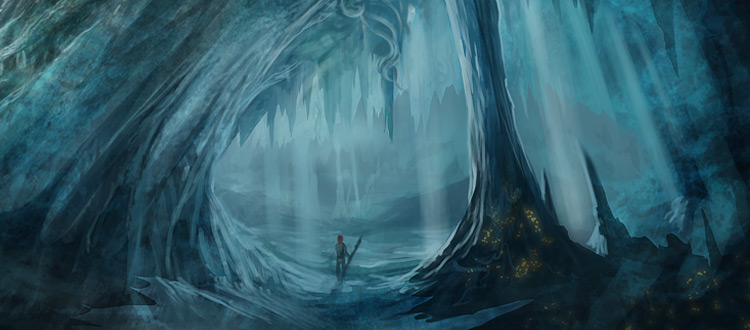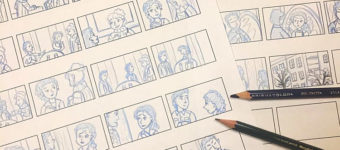
Best Digital Painting Books For Beginners
Entertainment artists mostly work digital and there’s often a rush for new artists to get into digital painting. This seems to be the way of the future whether it’s storyboarding, concept art, or even digital illustration work.
But if you’ve never done any digital painting before the task can seem daunting.
Where do you even get started?
All the books in this post will help you get a leg up on the task of digital painting. Some books target absolute beginners while others are for artists with experience who want to improve one area of their work.
Either way there’s bound to be a few books here that’ll help you improve the quality of your digital art.
Quick Tip: Beginners might prefer video lessons because they hold your hand with step-by-step lessons. For quality video tuts I suggest the Photoshop digital art path on Pluralsight. This teaches you everything about digital painting in Photoshop and it comes with a free trial period for testing.
Beginner’s Guide to Digital Painting in Photoshop


I have been consistently impressed with the 3DTotal books in the past few years. They’ve hit the nail on the head when it comes to publishing for entertainment artists, and more specifically concept artists who have no idea where to start.
Beginner’s Guide to Digital Painting in Photoshop is a complete introduction to the process of painting in Adobe Photoshop. The book contains 224 pages full of specific techniques, workflows, and suggested tips to help you build confidence with digital painting.
This guide doesn’t cover much about the actual tablet setup process or how to pick a tablet. It assumes you already know how to use a tablet but not a painting program like Photoshop.
Both authors are industry veterans with years of experience in concept art. They’ll cover some of the fundamentals like color selection and light sources to help you craft pristine works of art. But to get the most from this book it helps to have a little prior experience creating digital art.
Digital Painting Techniques: Practical Techniques of Digital Art Masters


Here’s another 3DTotal publication that gets a bit more advanced with the digital painting advice. You’ll study from other digital artwork with commentary and breakdowns of each piece explaining how to re-create similar effects on your own.
The book covers individual topics like painting creatures, humans, environments, and even how to pick your own custom brushes. Digital Painting Techniques: Practical Techniques of Digital Art Masters is not for everyone. You need experience painting before you pick up this book.
However you do not need to be a great painter beforehand. You just need to know what you’re trying to do and be willing to follow along with the exercises.
I do not think this book can make you a master painter any more than another book can. However digital painting is a different beast and I think Digital Painting Techniques gives this process the respect it deserves.
Beginner’s Guide to Digital Painting in Photoshop: Characters


This is a sequel to the very first book in this list which just focused on the basics of painting in Photoshop. Now you can get more into character art with Beginner’s Guide to Digital Painting in Photoshop: Characters.
Everything in this book prepares you for the process of building characters from scratch. You’ll learn about painting gestures and poses, choosing the right colors, and painting believable costumes for each character.
You’ll delve into the intricate details of hair, facial expressions, and nose/ear types that can radically change how a character looks on screen. This is not an easy book and you really need a higher level of painting skill before getting started.
I’d recommend this book to aspiring character artists who already know the fundamentals and want to move onto more detailed exercises. You can try this as a beginner but you will struggle. It doesn’t hold your hand through the fundamentals so if you’re a beginner this book should be used in conjunction with an easier title.
Digital Painting for the Complete Beginner


Carlyn Beccia wrote this book as an overall guide to digital painting. You can use Photoshop like many pro artists, but the techniques in this book apply to any program.
Digital Painting for the Complete Beginner teaches the fundamentals of painting from brush selection to the technique of laying down strokes on the tablet. Each chapter includes plenty of illustrations to guide you through the lesson.
I’d highly recommend this book to someone who already uses oils or watercolors and wants to move into digital work. Many of the exercises compare digital painting to traditional painting so you’ll have an easier time grasping these concepts if you already have some experience.
But even though you don’t need traditional painting experience you will need a bit of experience using your painting program of choice. The author uses Photoshop and Painter but you can use whatever so long as you’re comfortable.
Master the Art of Speed Painting


This is one of the most recently published books in this list and it’s also one of the most advanced.
Speed paintings are popular on YouTube where professional artists start with a blank canvas and speed up their work to create a beautiful painting in short periods of time(5-20 minutes).
As a beginner this is not advisable and would be a complete waste of time. This is comparable to an inexperienced musician who tries to jam freestyle on their guitar. It’s gonna sound bad because they simply don’t know how to play.
An expert artist can freestyle their work because they already understand the fundamentals. However some artists who do have experience still don’t know how to speed paint, and that’s the target audience of this book.
Master the Art of Speed Painting is 256 pages and covers a variety of speed painting techniques. You’ll learn how to paint in set intervals ranging from 10 minutes up to 60 minutes.
Speed is crucial in the professional world but you also need the underlying skills to go with it. Anyone who’s at the intermediate-to-advanced level of painting will get a lot from this book. If you have no experience then put in some hours of training first.
Art Fundamentals: Color, Light, Composition, Anatomy, Perspective, and Depth


There are so many fundamentals of art that it takes years to truly master them all. But you always have to start somewhere and many artists like to attack everything at once.
With this new book you can dip your toe into a little bit of everything! Art Fundamentals: Color, Light, Composition, Anatomy, Perspective, and Depth is a huge compendium written by professional game concept artists who know the importance of mastering these fundamentals.
This book is a powerful introduction to beginners who have no idea what the fundamentals are, why they’re necessary, or how they affect concept art paintings. You’ll learn about many different topics and why they’re crucial to great art.
However the book does not cover any particular skill in great detail. If you’re struggling with one skillset I recommend getting a specific book on that subject(ie. anatomy, perspective, lighting, etc).
And if you’re looking for book recommendations on specific art fundamentals then check out my fundamentals post to learn more.
Beginner’s Guide to Digital Painting in Photoshop: Sci-fi and Fantasy


Here’s another newer release in the “beginner’s guide” series of books from 3DTotal. This one focuses on sci-fi work and fantasy art made for video games, movies, and comic books.
Beginner’s Guide to Digital Painting in Photoshop: Sci-fi and Fantasy presumes knowledge of digital painting but not much beyond the core fundamentals. You should be able to do exercises on your own and paint without difficulty.
This book teaches you how to think about sci-fi work including characters, creatures, props, and environments. You’ll learn tips for powerful composition and lighting that sets the scene and helps sell your work.
Each chapter breaks down into smaller exercises with 12 individual projects to help you learn different tools of the trade. The book has three contributing authors with professional experience. I do think the topics are a bit scattered, but you can tell the authors know what they’re doing and the lessons are invaluable to anyone interested in sci-fi or fantasy painting.
Beginner’s Guide to Digital Painting in Photoshop Elements


I personally never use Photoshop Elements because it feels too watered down. However it is a much cheaper alternative to Photoshop so I feel it’s important to offer this book for artists on a budget.
Beginner’s Guide to Digital Painting in Photoshop Elements teaches you the basics of digital painting along with the PS Elements interface. You’ll learn how to select brushes, setup new canvases, and how to register your brush strokes with proper technique.
This isn’t all too different from Photoshop but there are noticeable changes in the interface and quality of the brushes panel.
You’ll learn through real exercises and practice projects that take you from a complete novice to a competent painter in PS Elements.
Light for Visual Artists: Understanding & Using Light in Art & Design


The physics of light is incredibly complex with reflected light and how it affects shadows. Without picking up a science book I’d recommend Light for Visual Artists to get started on this long journey.
Artists need to understand light sources and how they affect the scene. This is true with drawing but especially true with painting if you ever want to create believable works of art.
Early chapters look at the basic fundamentals of light and how this affects what you see. Then you’ll delve into colors and how light affects specific materials on humans and environments.
When painting from imagination you get to invent your own light source. But to do so you need a solid understanding of how it all works first.
This book should be used as a reference guide much like an anatomy book. You’ll constantly be referencing the rules and techniques of accurate lighting for realistic compositions. Light for Visual Artists is a great reference book for all skill levels and vital for aspiring concept artists.
The Photoshop and Painter Artist Tablet Book


If you come from a traditional art background then The Photoshop and Painter Artist Tablet Book will be the best book to help you learn digital painting.
The author Cher Threinen-Pendarvis assumes a natural background in drawing or painting and uses this knowledge to bridge the gap for artists who have never touched a tablet before. You should already have a tablet before reading this book, however you do not need any experience using it.
This book offers a nice mix of theory and practice with lessons that teach how digital painting works, then shows you with practical examples.
You’ll learn through a bunch of different programs like Photoshop, Painter, ArtStudio, and Sketchbook Pro. The author covers Wacom and iPad tablets but you can work with anything and still learn a lot from this title.
Digital Painting Tricks & Techniques: 100 Ways to Improve Your CG Art


Many digital artists are self-taught and eventually hit a brick wall. It can feel like you’ve plateaued and have no idea where to go.
Digital Painting Tricks & Techniques teaches a variety of techniques including brush selection, lighting, color picking, and even speed painting techniques. And while the book does start with “beginner” level topics, most of the information is not geared towards beginners.
You really need experience with digital painting before you pick up this book. It assumes prior knowledge of fundamentals and how to use your tablet as a drawing device. If you’re a complete beginner or just somewhat inexperienced then this book is not for you.
But if you’re open to new ideas and methods of painting then this book will offer a lot of tips. It’s not strictly reserved for professionals but you’ll get the most from this writing if you put in the hours and have prior knowledge.
Ordinary to Elegant: Transforming Photographs Into Digital Paintings


I can’t say this book will be for everyone because it targets such a specific topic. Many artists like to work from photos because they’re easier than finding a real reference.
But painting from a photo reference is tough enough with oils let alone digital tablets.
Ordinary to Elegant: Transforming Photographs Into Digital Paintings by Helen Yancy teaches how to study photographs and make artistic choices based on your knowledge of depth, perspective, and anatomy.
Helen has years of experience in photo manipulation and painting so her two skillsets merge nicely in this book.
If you like to setup photo references before you paint then this book is a godsend. But anyone who doesn’t care much for copying photos probably won’t want or need this title.
There’s so much to say about digital painting but there are only so many words that can be packed into a book. Most art is learned through repetition. Failure leads to insight when you then repeat and learn as you go.
Most of these books can help you learn how to do things properly, but they can’t make you better without action.
If you’re a complete beginner or just getting into digital painting then many of these books will be perfect for you. More advanced artists might find some titles valuable as well. But the best advice is to just keep practicing and putting in the hours. Once you understand the basics of digital painting it’ll be easier to improve and keep your momentum going.











